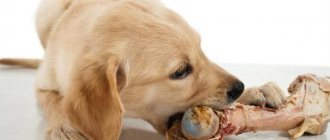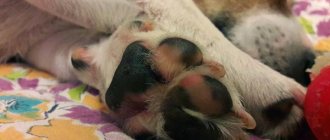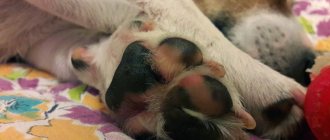Pet owners need to know how fungus manifests itself in dogs in the ears, paws, eyes, its treatment and symptoms with photos. The presented disease can overcome a representative of any breed. And often the prognosis of the disease depends on how quickly he receives help: the development of complications, recovery time.
No owner can completely protect their pet from such a problem. But with the systematic implementation of preventive recommendations, compliance with all requirements for the conditions of keeping the animal, he will be able to reduce the risks of infection and identify pathology in the early stages, when its treatment can still be carried out with a minimal investment of effort and resources.
Fungal pathogens in animals
Mycosis in dogs is caused by various microorganisms. All of them affect the skin and mucous membranes of mammals, provoke an inflammatory process and destroy tissue. The following types of fungi are most often found in pets:
- Trichophyton and microsporum. They cause ringworm, which affects the skin and coat.
- Fungi of the genus Candida. They provoke candidiasis of the vagina, eyes, mouth, intestines, nose, lungs. The presented disease is considered one of the most common.
- Malassezia pachydermatis. The pathogen usually lives on the skin of healthy animals. The reasons for the growth of fungus in a dog’s ears into a full-fledged disease are injuries, decreased immunity, fatigue, and hypothermia.
Is the fungus transmitted from dogs to humans? A sick animal can easily infect its owner if its immunity is reduced or there are lesions on the skin or mucous membranes. To avoid infection, a person needs to use personal protective equipment while treating their own pet.
It is imperative to use gloves and a gauze bandage; after contact with a sick dog, you need to wash your hands or treat them with an antiseptic. If there are other healthy animals in the house, they should be isolated from the sick pet.
Histoplasmosis
Histoplasmosis is a disease caused by the fungus Histoplasma capsulatum
. The disease is endemic in the USA, Latin America, Africa, Australia, and Asian countries. Infection occurs through aerogenic (inhalation) or nutritional (eating) routes. The spores of the pathogen can remain in dry soil for a long time; in a humid environment, the fungus actively multiplies.
In sick animals, there is a decrease in appetite, lethargy, signs of lung damage, and if the gastrointestinal tract is damaged, persistent diarrhea. Ulcers may form in the oral cavity, and enlargement of the lymph nodes is noted. The immune system is affected.
With histoplasmosis, severe conjunctivitis can develop, and if complications develop, complete loss of vision is possible.
Diagnosis is based on isolation of the pathogen (from sputum, bronchial washings, urine, cerebrospinal fluid, etc.) through microscopic examination or cultivation. Sometimes histological examination of the affected tissue is necessary. X-ray of the lungs can reveal characteristic lesions. For early diagnosis, an allergy test is used. There are also serological tests.
There is usually no treatment for histoplasmosis in animals. Due to the significant danger of the disease for people, sick dogs must be destroyed.
(c) Veterinary center for the treatment and rehabilitation of animals “Zoostatus”. Varshavskoe highway, 125 building 1. tel.
8 (499) 372-27-37
Routes of infection
A dog can become infected with such an infection as a result of contact with a sick animal (rat, cat, mouse, other dog), clothing or shoes of people on which fungal spores remain, through flea and tick bites. It is not always that after the pathogen enters the animal’s body, the pathology breaks down. This happens in the following cases:
- in the presence of chronic or acute diseases that have weakened the pet’s body;
- due to overwork of the beast;
- with vitamin deficiency, including those caused by poor nutrition;
- due to hypothermia, prolonged exposure to drafts;
- for severe allergies;
- during treatment with potent drugs.
The chances of infection increase in animals that have injuries on their bodies: scratches, abrasions, cuts. The group at particular risk of infection includes pregnant bitches, as well as puppies whose immunity has not yet fully developed.
Blastomycosis
Blastomycosis is a disease caused by the fungus Blastomyces dermatitidis
. The pathogen lives in the soil, is endemic in some areas of the USA and Canada, and is found in Africa, Australia, India, and some European countries.
Infection occurs by inhaling spores of the pathogen, primarily affecting the respiratory system. The pathogen subsequently spreads throughout the body.
Symptoms of blastomycosis: cough, difficulty breathing, fever, loss of appetite, weight loss, formation of nodules on the skin. Neurological symptoms (head tilt, seizures) may be present. When bones are affected, lameness develops. With the development of inflammation in the genitourinary system, blood in the urine and difficulty urinating are observed.
With the development of an eye infection, the disease manifests itself as squinting, the development of blindness with damage to the retinal vessels, uveitis, and secondary glaucoma may develop.
Diagnosis of blastomycosis is made on the basis of serological tests or, more reliably, on the basis of isolation of the pathogen from the affected tissues during microscopic examination or cultivation. If the lungs are affected, radiography is used.
Systemic antifungal drugs are used to treat blastomycosis.
Symptoms of the disease
It is not difficult to determine the development of pathology in an animal. This can be done based on the following signs common to various groups of mycoses:
- Severe itching that bothers the dog. A sick dog will intensively lick or bite the damaged areas, which is why bald patches and age spots will soon form on them. The skin in such areas turns red, peels, and often becomes covered with brown or greenish crusts. Similar manifestations of mycosis are observed on the dog’s stomach and paws.
- The appearance of purulent discharge from the ears, damage to the eyes. The skin and mucous membranes in these areas swell and acquire a red tint.
- The appearance of an unpleasant odor from your pet.
- Damage to fingers. Dry crusts form on the skin between the fingers and on the pads, which crack over time. Creases and cracks appear on the claws. They also become deformed and change color.
The intensity of the symptoms presented depends on the general condition of the animal, the type of mycosis, and the presence of concomitant diseases. As the pathology progresses, it will increase.
In the chronic form of the disease, symptoms are less pronounced. Animals experience a deterioration in the quality of their fur, which becomes dull and sparse. She herself falls out a lot, whitish spots may form behind the ears and on the face. Otherwise, the pet’s behavior does not change. He can maintain his former activity and does not lose his appetite.
Cryptococcosis
Cryptococcosis is caused by the fungus Cryptococcosis neoformans
. Infection of humans and animals occurs through inhalation of spores. The natural reservoir is birds (for example, pigeons), which release spores in their droppings. The birds themselves rarely get sick, since elevated body temperature prevents the fungus from developing. The disease is widespread throughout the world.
The pathogen spreads throughout the body, often affecting the nervous system. Symptoms include general lethargy and weakness, signs of damage to the nervous system (convulsions, lack of coordination, maneuvering movements, head tilt, damage to the facial nerve, etc.), and in half of the affected animals, nodules form on the skin.
Eye lesions manifest as retinal hemorrhages, chorioretinitis, and anterior uveitis.
For diagnosis, serological tests, biopsy examination, and microscopic examination of exudate are used.
Treatment includes systemic antifungal drugs such as amphotericin B, flucytosine, ketoconazole, itraconazole and fluconazole. Sometimes surgery is required.
If the nervous system is damaged, the prognosis is cautious.
How to diagnose the disease?
When the first signs of mycosis are detected, it is important for a person to show the animal to a veterinarian. He must examine him using a special lamp and order a series of tests. Among them:
- General blood and urine analysis. Allows you to determine the current state of the animal.
- Blood test for allergens, biochemistry. Allows you to determine the cause of infection.
- Scrapings from affected areas of skin. This study is used when there are difficulties in making a diagnosis.
The presented diagnostics are necessary for an accurate diagnosis and creation of an effective treatment regimen. Without such an examination, most methods of combating mycosis will be ineffective.
Treatment of fungus in dogs
For mycoses, animals are prescribed drug therapy, which is selected depending on the type of pathogen, the general condition of the dog, and the presence of contraindications to the use of certain drugs. This treatment is based on the use of local agents that restore the skin and eliminate itching, as well as general medications to fight infection. The most effective remedy is a fungal vaccine for dogs, which allows you to cope with the infection quickly. Let's consider methods of combating the most common types of mycosis.
Ear
This pathology is usually not contagious and does not require the use of potent drugs. Typically, when diagnosed with “fungus in a dog’s ears,” treatment is limited to the use of the following medications:
- Ear drops. Oritsin, Bars, Amitrosine are used for such purposes.
- Shampoos: Nizoral, Imaveron, which have an antifungal effect. Allows you to exclude damage to neighboring areas of the skin.
- General funds. Used when the animal's immunity is reduced. Giseofulfin and Fluconazole are considered the most effective in this regard. They can be prescribed to the dog either in the form of injections or in the form of tablets.
If systemic medications are recommended for an animal with otomycosis, the doctor can also prescribe immunostimulants, immunomodulators, and hepatoprotectors. The latter are used to support the liver, which can be adversely affected by antibiotics.
The duration of treatment and dosage regimen are determined for each sick individual individually. Unauthorized changes in medical recommendations at the request of the dog owner are unacceptable, as this can lead to a deterioration in the pet’s health.
On my paws
In these cases, therapy comes down to taking the above systemic drugs in the form of tablets, injections, and local remedies:
- Antifungal ointments, including Dermatol, Miconazole, Akriderm.
- Sprays They are used to treat fungus on the skin after bathing your pet.
- Tar shampoos.
- Folk remedies, for example, oregano oil. They can be used for short-term relief of symptoms if the dog owner is not able to see a doctor right away. They are not considered as main drugs.
Treatment with such products at home should be carried out several times a day. Also, in case of skin lesions, a person needs to boil the dog’s bedding, treat his accessories (collar, leash), toys with an antiseptic. If the place has had contact with an allergen, it is necessary to isolate the pet from it. You can limit your dog's walking until he has fully recovered. This issue must be resolved with a veterinarian, taking into account the general condition of the pet, the location of the fungal infection, and the level of immunity.
Ophthalmic
For such forms of mycosis, complex treatment is recommended, including:
- Taking antifungal eye drops. Depending on the veterinarian's recommendations, they are instilled up to 3 times a day. Both eyes are treated, even if symptoms of infection are recorded in only one.
- The use of ointments applied to the mucous membrane of the eyelid.
- Vaccination of the animal, injections of antibiotics. They are prescribed if the fungal infection in the eyes is secondary and develops against the background of another acute or chronic disease.
When treating mycosis, it is recommended to wear a special collar for the animal. This way, he will not be able to injure the skin around the eyes and mucous membranes and introduce infection to the affected area after treating it with drops or other drugs. The same applies if the disease appears on the animal’s lip or nose.
Video: what to do if your dog has fungus in the ears, paws or eyes?
How can mycetoma be cured?
Is it possible to do without surgery? It is impossible to get rid of fungus in the maxillary sinus without surgical intervention, I will say this right away. No pills, no drops of “dancing with a tambourine” and everything else will give the desired therapeutic effect. First of all, it is necessary to surgically remove the fungal body, remove this mycelium, remove all the fungus from the maxillary sinus.
This can be done either through a nasal surgical approach or an intraoral approach.
How to remove fungus from the maxillary sinus
With intraoral access, a perforation is made in the vestibular wall of the maxillary sinus - access, and evacuation occurs through this hole, i.e. removal of the fungal body, mushroom mycelium. Then the maxillary sinus is well washed, treated with antifungal and antimicrobial drugs and sutured. Subsequently, the patient is prescribed antifungal therapy.
Surgical removal of mycetoma shows good results today, relapses are extremely rare.
Prevention
Avoiding fungal infections in your pet is easier than treating the pathology. It is enough to follow simple preventive recommendations:
- Keep your pet's enclosure clean and regularly wash its bedding if it lives in an apartment.
- Isolate the dog from contact with stray animals that may be carriers of infection.
- Bathe your pet on a schedule; do not wash it with special shampoos more often than recommended by your veterinarian.
- Provide good living conditions for your four-legged friend. Don't overload him with training.
- Visit the veterinarian in a timely manner with your pet. If signs of various diseases appear (even if they look like minor damage to the skin or mucous membranes), begin treatment immediately. Vaccinate and deworm the animal according to schedule.
The dog breeder also needs to monitor the state of his dog’s immunity. If signs of vitamin deficiency appear, the animal owner should contact a veterinarian, select vitamins for the dog and give them strictly according to schedule. By following these simple rules, you can avoid mycosis in your pet.
First aid for blepharitis:
If your pet shows signs of blepharitis, put a protective collar on it. This measure will help avoid the unpleasant consequences of self-trauma. You can treat the eyelid with saline solution or 0.05% chlorhexidine solution. We do not recommend the unauthorized use of antibiotics or immunosuppressive drugs, since this can not only harm the pet, but will also necessarily blur the clinical picture. This means it will increase the time it takes to find the cause.
Veterinarian ophthalmologist Yastrebov O.V.
Join us on social networks











